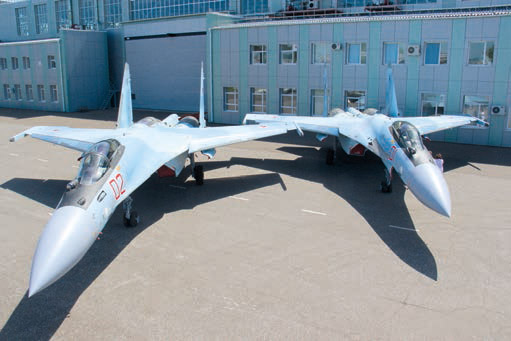|
 On 16 July 2015, the common day of materiel acceptance by the Russian Defence Ministry, the Sukhoi company delivered two Su-35S supermanoeuvrable multirole fighters to the Russian Air Force at the Komsomolsk-on-Amur Aircraft Plant - the first two of 14 to be delivered this year. Thus, as many as 36 out of the 48 aircraft of type stipulated by the contract landed in 2009 have been fielded with combat units since 2011. Two squadrons of the Fighter Air Regiment stationed at Dzyomgi AFB in the Khabarovsk Territory converted to the type in 2014 with four Su-35S fighters were ferried to the Air Force Training and Operational Evaluation Centre in the city of Lipetsk in late May 2014. Here they are used by the centre's personnel to test new tactics being developed for the advanced fighter and for the training of the flying and ground crews of RusAF combat units converting to the type. On 16 July 2015, the common day of materiel acceptance by the Russian Defence Ministry, the Sukhoi company delivered two Su-35S supermanoeuvrable multirole fighters to the Russian Air Force at the Komsomolsk-on-Amur Aircraft Plant - the first two of 14 to be delivered this year. Thus, as many as 36 out of the 48 aircraft of type stipulated by the contract landed in 2009 have been fielded with combat units since 2011. Two squadrons of the Fighter Air Regiment stationed at Dzyomgi AFB in the Khabarovsk Territory converted to the type in 2014 with four Su-35S fighters were ferried to the Air Force Training and Operational Evaluation Centre in the city of Lipetsk in late May 2014. Here they are used by the centre's personnel to test new tactics being developed for the advanced fighter and for the training of the flying and ground crews of RusAF combat units converting to the type.
The Su-35S single-seat supermanoeuvrable multirole fighter is the summit of the evolution of the Su-27 fourth-generation aircraft family. The Su-35S's development involved a wide range of solutions and technologies used under the PAK FA (T-50) fifth-generation fighter development programme. Therefore, despite its outward similarity to the ubiquitous Su-27 and Su-30, the Su-35S is rightfully regarded as an aircraft featuring radically advanced capabilities, which attributes it to Generation 4++.
The advanced fighter's features setting it apart from the rest of the Su-27 family are the latest avionics suite that is based on a digital information management system and the advanced Tikhomirov-NIIP Irbis electronically scanned radar. The latter enjoys the unique aerial target acquisition range and a beefed-up simultaneous multiple-target tracking and engagement capability (tracking 30 and engaging eight aerial targets or tracking four and engaging two ground targets).
The flight tests have proven the basic characteristics of the latest electronically scanned radar, with most of the latter's operating modes having been tested. In particular, test sorties have proven the unique ability of the Irbis to acquire threats at a range of more than 400 km.
The avionics suite of the Su-35S also incorporates an advanced IRST from the Precision Instrument Systems scientific and production company, up-to-date navigation and communication systems and a sophisticated defensive aids suite comprising missile warning and laser warning gear in addition to the traditional radar warning receiver and electronic countermeasures system. The cockpit management system comprises two 15-inch colour multifunction liquid-crystal displays and a large head-up display.
The fighter is powered by a pair of advanced enhanced-thrust 14,500-hp extended-life 117S thrust vector control engines developed by the Lyulka Scientific and Technical Centre and produced by UMPO JSC. This, coupled with advanced operating algorithms of the integrated aircraft control system, allows supermanoeuvrability in dogfight. Compared to the Su-27, the Su-35S features an increased internal fuel capacity, the mid-air refueling system and drop tanks.
The weapons suite is comprised of both the in-service smart and dumb air-launched weapons and their modernised variants, with drastically innovative missiles and smart bombs to be carried further down the line.
The first two Su-35 prototypes (in export version) started their flight trials in 2008, and August 2009 saw the Sukhoi company and Russian Defence Ministry clinch a long-term deal for a 48-ship Su-35S batch to be delivered in 2011-2015.
The first four production-standard Su-35S fighters were made by Sukhoi's Komsomolsk-on-Amur Aircraft Plant (KnAAZ) and delivered between May 2011 and March 2012. They have been undergoing the official tests at the Defence Ministry State Flight Test Centre in Akhtubinsk since 2011. Then in December 2012, the Defence Ministry took delivery of six more production standard aircraft designed for the test programme and, that completed, for the conversion of the air crews of RusAF combat units at the training and opeval centre in Lipetsk. The planes were ferried from Komsomolsk-on-Amur to Akhtubinsk during January through February 2013.
The next 12 fighters were handed over to the Russian Defence Ministry in a ceremony held at the Komsomolsk-on-Amur Aircraft Plant of the Sukhoi company on 12 February 2014. They were fielded with the first squadron of the Fighter Air Regiment stationed at Dzyomgi AFB which launched regular operation of its advanced Su-35S fighters on 24 March 2014. The second squadron at Dzyomgi AFB was converted to Su-35S in October-December 2014. New aircraft to be delivered in 2015 are supposed to be fielded with the next RusAF's Fighter Air Regiment. A new contract for another large batch of Su-35S fighters is to be signed with Russian Ministry of Defence in the nearest future.
Published in Take-off magazine, November 2015.
(Photo: Andrey Fomin)
|
